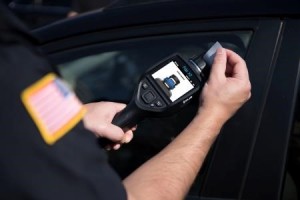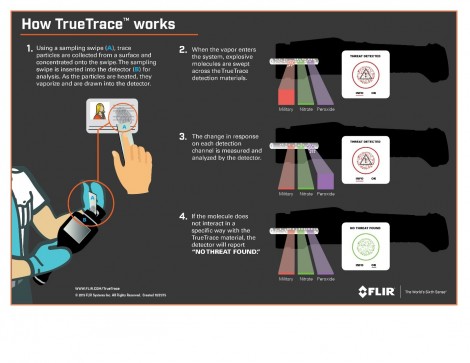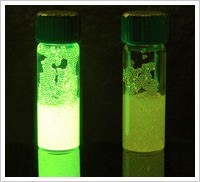
Historically, defense and homeland security agencies have been the primary users of trace explosives detection technology. However, as illustrated by recent events, the threat of violent extremism extends beyond battlefields and mass transit systems. Law enforcement agencies in communities around the world are depending more than ever on proactive and preventative technologies to keep the public safe. Recent technological advances have enabled the development of next-generation, handheld explosives trace detection (ETD) tools designed specifically for the modern police force.
Why does trace detection matter?
Explosives do not have to be carried by a terrorist to be detected. Trace residue can be left on a bomb-maker or their property for an extended period after handling explosives. Concealed bombs can leave trace chemical signatures behind, which indicate the presence of a threat. Innovative technologies like FLIR’s TrueTrace core have advanced handheld ETDs to the point that they can sense what the human eye cannot see.
TrueTrace is a patented, multiplexed luminescence technology unique to all FLIR Fido X-Series handheld ETDs. In the earliest versions of Fido, a detection material called Amplifying Fluorescent Polymer (AFP) was used due to its incredible sensitivity and speed of detection. As new explosives threats emerged, other fluorescent and chemiluminescent materials were added to the TrueTrace platform to detect a broad range of homemade, commercial, and military explosive threats while maintaining the sensitivity and speed of AFP.
Each TrueTrace sensing material is uniquely formulated to react to a specific class of explosives, enabling Fido X-series products to detect homemade explosives like Triacetone Triperoxide (TATP), as well as a broad range of commercial, military and fertilizer-based explosives, with unmatched sensitivity. Using TrueTrace, Fido X-Series ETDs can detect less than a nanogram of trace explosive material. A nanogram is 1/1,000,000,000th of the weight of a paperclip. This trace evidence provides actionable intelligence, and can lead to catching a terrorist ahead of the act, rather than after the fact.
How TrueTrace works
Using a sampling swipe, trace particles are collected from a surface like a transit or event ticket, identification card, backpack, or door handle. The sampling swipe is inserted into the detector for analysis. Inside the detector, the sampling swipe is heated to vaporize the trace sample. An internal pump pulls the vapor phase molecules across the suite of TrueTrace sensing materials, each tuned to specific explosive threats. These sensing materials interact with molecules in the vaporized sample, causing a change in light intensity. The change in intensity of light output is measured by ultra-sensitive detectors in the Fido X-Series ETD and the identity or class of the explosive is displayed on the screen. All of this happens in a rapid ten-second timeframe. No radioactive ionization source is needed to produce this result. An explosive is “sensed” when the light output of the TrueTrace sensing materials changes in a specific manner in response to explosives in the sample.

TrueTrace maximizes system availability during high-threat scenarios with quick three-minute start-up and fast ten-second analysis
FLIR uses AFP technology licensed from the Massachusetts Institute of Technology (MIT). AFP consists of many fluorescent molecules linked together to form a 'wire' that communicate with each other electronically. When any one of the molecules in the wire interacts with a molecule of explosive, all of the molecules in the wire stop emitting light. This is similar to an old-fashioned string of holiday lights that all go out when a single bulb burns out. A single explosive molecule switches off the fluorescence of multiple fluorescent molecules in the chain. An extremely small amount of explosive can trigger a measurable reduction in light output, enabling FLIR's TrueTrace technology to provide best-in-class sensitivity.

Law enforcement applications
Terrorists rely on their knowledge of predictable security patterns, such as standard checkpoint screening, to carry out attacks. If the security protocols of law enforcement agencies change rapidly, adversaries have a harder time predicting what type of screening will be encountered. New tools like the handheld Fido X2 TrueTrace detector from FLIR systems enable police forces to add an unexpected layer of security at a checkpoint or extend actionable intelligence capability beyond the fixed-site checkpoint.
By using a highly-mobile and easily-operated explosives detector, law enforcement personnel can further develop actionable information in a crisis situation. By using the standard of “totality of circumstances,” the operator is able to make appropriate decisions in high-consequence situations. This means that no single deciding factor is used in the decision making process.
When used in a random screening environment, a handheld explosives detector can interdict an explosive threat, like an improvised explosive device (IED). This initial presumptive information enables law enforcement officers to blend sets of information including advanced intelligence, on-site human intelligence, tactical canine operations, and additional sensor data to make decisions.

FLIR’s Fido X2 handheld ETD uses leading-edge TrueTrace technology
At 1.5 lbs, Fido X2 can go anywhere the police officer goes. It can be used to screen vehicles, mail, cargo, and personal belongings to determine if they have come into contact with explosives. Handheld explosives detectors have been deployed at metro stations, bridges, tunnels, major sports venues, and critical infrastructure locations during random screening, area reduction, and post-blast sweep missions.
Electronic trace explosives detection equipment can be a valuable tool in the overall public safety mission of law enforcement. A handheld ETD provides the most value when deployed as part of a comprehensive plan for increased vigilance. With new levels of portability now available, security teams have more deployment options than ever. These tools allow a rapid and adaptable response to emerging threats, helping law enforcement detect and deter threats before they occur.
Written by Patrick Call, Regional Sales Manager, and Clint Wichert, Director of Product Management, FLIR Systems, Inc.































 Back to Features
Back to Features

























